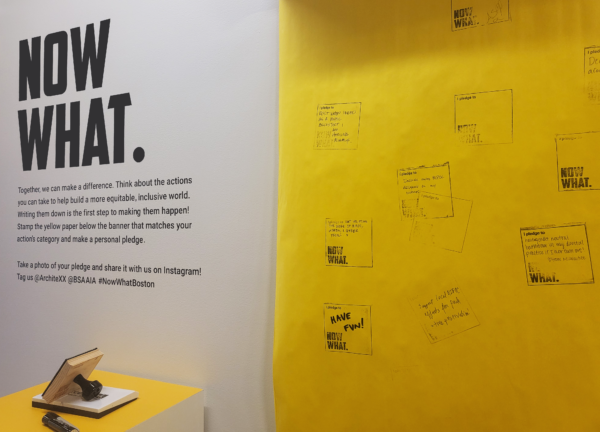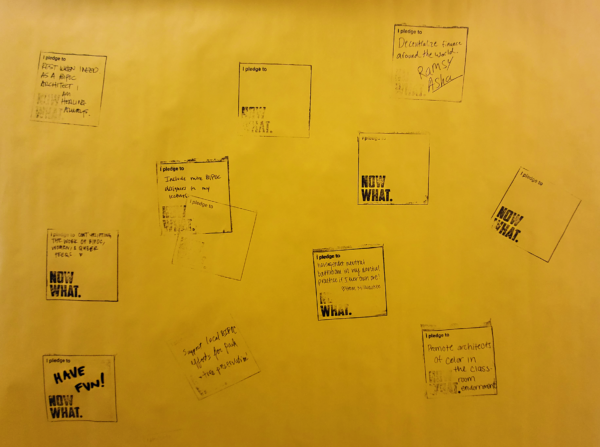Now What?! exhibition designers shape an immersive and accessible gallery experience

We sat down with the dynamic design duo who brought Now What?! Advocacy, Activism & Alliances in American Architecture Since 1968 to the BSA.
Now What?!, a traveling exhibition that links the design community to larger social and political movements of the late 20th century, is now on view at the BSA. As programming for the exhibition kicks off, we sat down with Jessie Rubenstein and Mary Yang, who designed the Boston component, for an inside look at how they gave Now What?! a new look and feel for BSA Space.
Rubenstein and Yang will be leading Now What?!—Exhibition Design and Social Practice on Friday, April 29. This informative discussion and tour of the exhibition is free and open to the public.
This interview has been condensed and edited for length and clarity.
Can you speak about your backgrounds and how you got involved with NowWhat?!?
Jessie Rubenstein: I'm an exhibition designer and founder of Marks + Spaces. I've worked on a variety of exhibit projects over the years, ranging from ones that focus on social history, to ones that are more art-based. As I learned about Now What?! Boston, I became aware of how the exhibition's development aligned with my personal goals for exhibition design. I like to think about exhibition design as a medium and a platform for connecting people with stories—particularly stories around critical topics—and giving them space to engage with the content and each other.
At the time I was teaching at BU with Mary, and it seemed like it could be a really wonderful collaboration. My background is in 3D design, and the project also needed a graphic design team member. So I reached out to Mary, and she and I have been on the project together.
Mary Yang: I'm a graphic designer, and I also teach full-time at BU in the graphic design program. I run my own practice, called Open Rehearsal, and I've been working a lot with curators, whether that's in art spaces, cultural institutions, academic institutions... So I've always enjoyed working in more spatial environments, and thinking about how 2D interacts with 3D.
Since we were both teaching at Boston University, we had the chance to work with a small group of students from the College of Fine Arts, and the History of Art and Architecture department.
How did that collaboration with students look?
Rubenstein: One of the things it really allowed us to do was slow the process down. Not only is it meaningful to engage someone who's just learning about design and give them real constraints and a real space, but it also allows you to really think about so many different opportunities and ideas that Mary and I might have skimmed over had we been working individually.
How did you approach shaping the existing exhibition content around the BSA gallery?
Rubenstein: The way it looks now has a very different form to the way it looked when it came to us. The content is so deep and compelling, but when you're in a space, you're thinking about many different types of visitors. When you have visitors who work in your building and walk through the space every day, you want to create levels of information to reach people wherever they’re at when they come through the door.
Yang: We're thinking about how the scale of the information can really impact the takeaway each type of person gets. All the typography was scaled up when thinking about ADA (Americans with Disabilities Act) compliance, and how someone could be able to read [the text] from a big distance. So we were thinking about how we could make the content visually accessible to the audience as well.
Rubenstein: We also had the asset of the beautiful BSA space. It's a great space for exhibitions; the timeline laid out really nicely on the exhibition walls. [While] spending time with students, we [...] played in the space a little bit differently than if it had just been Mary and I. Spending time in the space allowed us to [realize] that this is an area, at the end, where we really want people to gather, and be immersed in the content but also with each other.

What design elements did you consider to encourage people to participate?
Rubenstein: One of the really wonderful things about the timeline itself is that it acknowledges that it's not a fixed history—that its history is in progress, and it's continuing to be written. And that the visitor is actually an active writer of that history itself. Part of the experience is having a large table where visitors can come, add a tab, write their own event, and include it in the timeline.
Yang: On the walls we actually have these open placeholders, these dotted lines, so you can see that there are missing panels. We acknowledge that not everything has been included, and that it is a growing timeline that can evolve over time.


Images by author
Rubenstein: And I'd say the last area for participation is at the end—this idea that we say "now what?" as a statement and not an explanatory question. It's a place for visitors to make a pledge to turn everything that they've learned about design advocacy back to themselves and think about what they might do.
It's fun for an adult to make a stamp and write on the wall—that's not something we're often invited to do. It's also fun for children to do that! It changes the dynamic of the way we're processing the information. It's not that everything is just coming to us—there's an exchange that's happening between the space, and the visitor, and the content.
What do you want visitors to take away from the exhibition?
Rubenstein: In terms of an emotional response, I think we want people to understand that the built environment is up to us. We all are changemakers, and we can look to the people who have created exemplary examples in the field of architecture and design and think about what they're doing, the conversations they're having, and find ways for ourselves to engage in those same conversations and understand that every voice is valuable.
Yang: I also want to add that this exhibition is not just for architects or people in design. Anyone can have some sort of takeaway, especially since the exhibition is broken down into these four categories—advocacy, representation, workplace, and academy. I think everyone kind of falls within one of these categories in their daily lives. I hope it allows people to reflect on small changes they can make. As we've been reading through some of the pledges on the pledge wall, some of them are as easy as saying "I'm going to be more thoughtful in the work that I'm sharing as a teacher." Some of them aren't even design-related. But it does allow people to think about the small actions they can take to be a part of change in their communities.
Another thing that is really interesting about the timeline is that it provides these contextual events. So as you're seeing important events in history, like someone being elected president, or a certain bill being passed that year, you can see how that affected the design and architecture community. Anyone can relate to it, because we can all see ourselves in that timeline in some way.

What can attendees expect at the April 29 event, "Now What?!—Exhibition Design and Social Practice"?
Rubenstein: If people would like to hear more about the exhibition development from Mary, myself, and Masters candidate at the Harvard Graduate School of Design, Ilana Curtis, we're going to be talking about the development of Now What?! Boston specifically, but also the ways in which exhibition design can serve as a medium for activism and social practice. We plan on doing a tour of the gallery and also having a hands-on making component. Come on down and add your story!
Can't get enough of Now What?! Join us for the Opening Reception at 6:00 PM on Thursday, May 5, to celebrate the exhibition along with the reopening of BSA Space! This even will be free and open to the public but advance registration is strongly encouraged.

